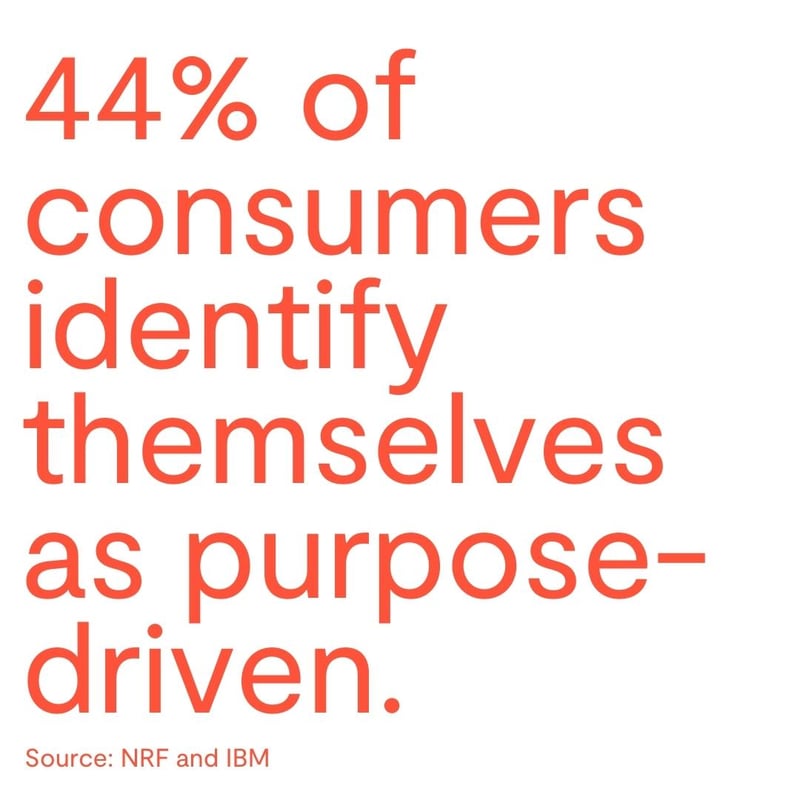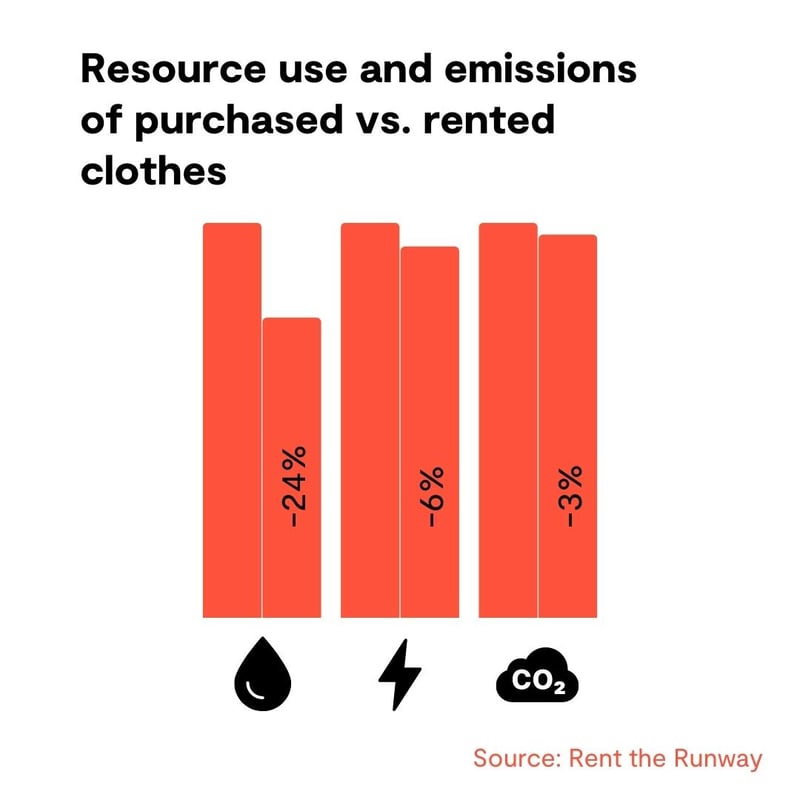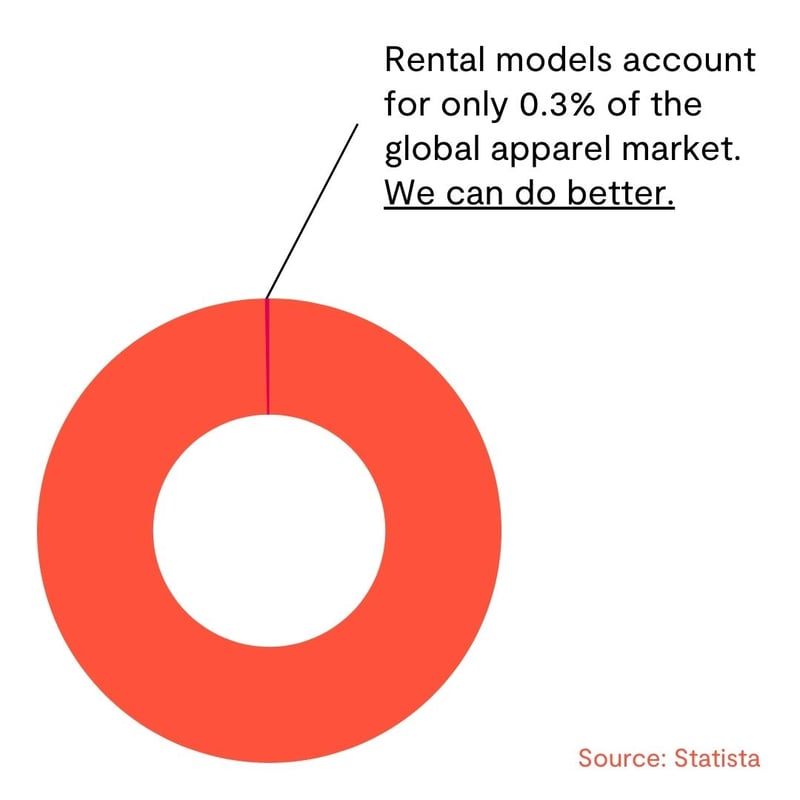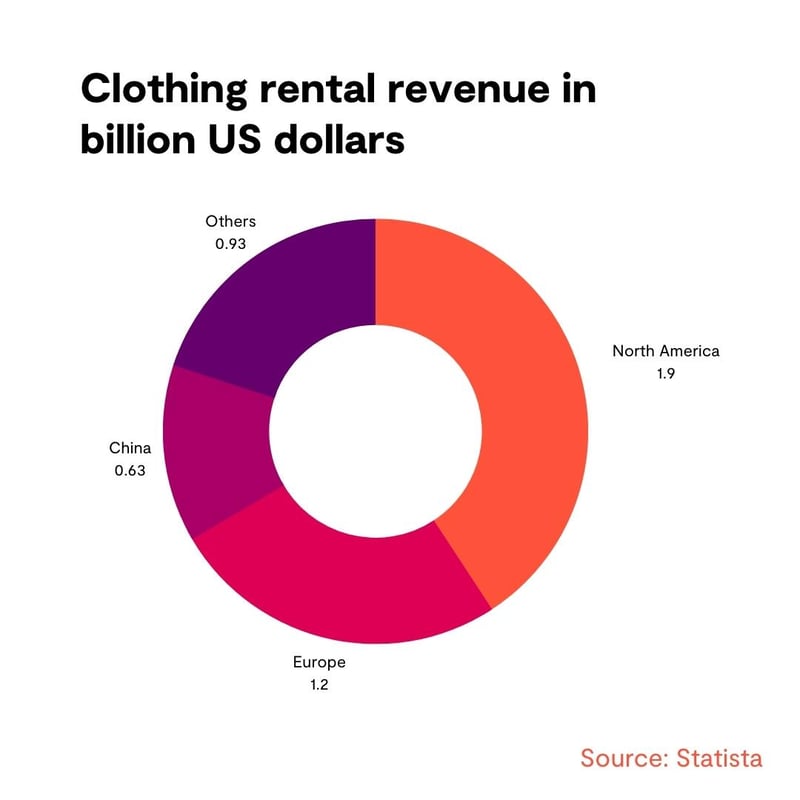The global online clothing rental market is thriving as the fashion industry is serious about its sustainable transformation. This situation represents an excellent opportunity for rental and e-commerce businesses to capture market share in a sector experiencing significant growth.
This article will examine the key factors driving clothing rentals and identify the main drivers and barriers affecting future growth.
Why the global online clothing rental market has emerged
There are strong signals that the global online clothing rental market is undergoing rapid growth. For instance, fashion rental pioneer, Rent The Runway recently reported all-time high revenues from Q2/2022, while other reports suggest that the market is expected to grow 10% year-on-year until 2027. In financial terms, that translates to a market size of USD 2.14 bn. There are several reasons behind the rise of clothing rental, and many of these factors speak to the industry's long-term potential.
Clothes rental isn't exactly a new sector. People have been renting garments for theme parties and black-tie events for many years. Additionally, clothes rental has long been part of the film, television, and media worlds.
In the past, renting clothes involved going into physical stores. However, today the clothing rental market is growing online. E-commerce caters to a different audience and supplies a much more comprehensive range of fashion. Moreover, traditional one-off rentals have been joined by recurring clothing subscriptions and peer-to-peer sharing. This has led to people using rented clothing for much more than special occasions.
Before diving into the market analysis, let's observe some key market trends and developments that are powering the industry.
Sustainability
Millennials and Gen Z are environmentally conscious, and sustainability plays a crucial role in their shopping behavior. According to NRF and IBM report (2022), half of the consumers say they're willing to pay a premium for sustainability, while 44% identify themselves as purpose-driven, choosing products and brands based on how well they align with their values.

The resource waste and pollution caused by fast fashion trends have been a subject of much discussion in recent years in the fashion industry and beyond. Clothing rental can solve many of these issues. Instead of consumers buying a garment, wearing it only a few times, and forgetting it, clothing rental can ensure each garment gets more wear during its life cycle. Combined with efficient recycling and resale processes, companies can significantly extend the life of materials and garments.
Online fashion rental brand Rent the Runway (RTR) conducted a study into clothing rental sustainability. RTR's research methodology was simple. They surveyed users and compared the life cycle of purchased vs. rented clothes. Their findings were very encouraging and suggested clothing rental reduces:
-
water use by 24%
-
energy use by 6%
-
CO2 emission by 3%

Furthermore, Circos estimates it helps its customers save 242 liters of water and 6 kilos of CO2 emissions per month compared to parents who purchase their children's clothes.
This is a big win for online clothing rental when added to the other advantages. Each new generation becomes more environmentally conscious, so the utility of online rental clothing should continue growing as consumers pick options that reduce the pressure on natural resources.
Supply chain disruption
We're living through a challenging era for global supply chains. A few factors are at play, such as COVID-19, the Suez Canal blockage, labor shortages, and inflation. The supply and manufacturing of goods are taking longer and costing more. These expenses are being passed down to the consumer via inflation.
However, online clothing rental isn't entirely subject to the same pressures. A paper from the Ellen McArthur Foundation and Bocconi University finds that the more circular a company is, the less vulnerable it is to external shocks such as price fluctuations and supply chain risks. With an inventory that isn't reduced by each sale, companies always have stock to sell even if supply chain issues peak again.
Dwindling spending power
Inflation is soaring, with gas and energy prices sky-high, leading to a rising cost of living affecting most consumer goods. The result is that consumers' spending power is being curtailed. According to Thredup's resale report, 44%of consumers say they're cutting back spending on apparel, second to only restaurants.
In a world where the social pressure to follow the latest trends is high, renting fashion allows consumers to access high-quality garments at reduced prices. As belts tighten, this option will increase in attractiveness.
Technological development
While the in-store still has a significant role as a shopping channel in the apparel and footwear category, many consumers rely on online and hybrid shopping experiences. This trend is driven by technological advances that have made it easy for anyone to open an online store with almost no budget. The same development is now moving into the rental economy as many rental-focused e-commerce platforms, such as Twice, have entered the market.
Even though much of shopping is done in-store, digital touchpoints in the shopping journey play a crucial role in today's world, where consumers expect speed, ease, and convenience. If not for direct purchase, then for research and learning about products.
By presenting the product catalog attractively, showing live inventory availability, making online booking fast and easy, and offering convenient delivery and return options, online clothing rental brands can increase the likelihood that consumers will consider rentals as an alternative to buying.
Overall market size and estimated market growth
In 2021, the global clothing rental market was valued at around $4.66 bn, out of which $1.2 bn was accounted for online clothing rentals. In the $1.55 trillion global apparel market, rentals cover only a tiny drop in the ocean. However, rental-based business models offer brands an opportunity to reach new customers and one potential instrument for the green transition in the fashion industry.

Additionally, women account for around 58-64% (Market Data Forecast, 2022; Future Market Insights, 2022) of global clothing rentals, forming the largest customer segment in terms of end-users. When observing the market through the clothing type, formal clothing has the largest market share, with 48%.
In the following chapters, we'll perform a detailed analysis of the online clothing rental market by looking at the key market definition and size alongside market trends that will affect the online clothing rental service over the next years.

Europe
Europe's clothing rental market stood at $1.2bn in 2019 and is expected to double by 2025. Since e-commerce accounts for about 25% of the total industry turnover, we can conclude that the European online clothing rental is worth around 300 million USD. It's the second-largest clothing rental region, behind North America, with a 27% market share.
The market is expected to have a compound annual growth rate (CAGR) of around 12%. In 2022, when events started to be organized again, the overall industry is set to recover from the impact of COVID-19 with annual market growth of 60%. From 2023 onwards, the market growth is expected to slow down and settle on both sides of the six percent.
North America
The largest market for clothing rental is North America. In the US, the annual value of clothing rental was around $1.9 bn in 2021, while online share stands at approximately $475 million. The overall market is expected to reach $3.7 bn by 2026. Today, the North Americas makes up about 42% of global online clothing rental.
Market forecasts suggest that in 2021 and 2022, the clothing rental market in the Americas will recover from the impact of COVID-19 with 26% and 13% annual growth, respectively. From 2023 onwards, a similar trend can be seen as in Europe, with growth expected to stabilize at around 4%.
Asia Pacific
The Asia Pacific is an emerging region in clothing rental services. China is the most important country in the area, with an estimated clothing rental market size of $632 million. Japan, South Korea, and India are other primary countries for clothing rentals. Today, it accounts for just over 20% of the global online clothing rental market, but some forecasts suggest that approximately 44% of the market growth in clothing rental will come from the APAC region.
Online rental clothing rental market segmentation
In addition to regional market segment analysis, we can look at the clothing rental market through several other criteria. The following section will review the most typical market segments, including demographics and clothing types.
By demographics
Segmenting the online clothing rental market by demographics is a common way to slice and dice this industry. This can be done by analyzing different age groups, genders, sociodemographic factors, and geographic areas.
If we look at the gender of the consumer, the women segment holds at least 58% of the online clothing rental industry, followed by men and others. Currently, the male segment has shown limited growth compared to women and children. However, that looks set to change, with an estimate suggesting an above-average CAGR of 12.5%.
One potential reason for the success of the women segment is that the largest companies in the sector are mainly targeted at women. Women are also more sensitive to changes in style, which makes rental services a more attractive option for them. When defining the target group, however, you must always draw more profound conclusions together with the type of clothing and the occasion.
Looking at the age, consumers aged 18-34 seem to have the most experience using fashion rental services. Another study (Gilliot, 2019) reveals that the primary age segment for women's fashion rental brand, Le Tote, is about 35 years.
In the children's clothing segment, 44% of German parents could imagine using a subscription-based service to dress their children (Bodenheimer, M., Schuler, J., Wilkening, T., 2022). While the authors noted little difference in sociodemographic characteristics in the intention to use children's clothing rental services, the actual users of such services represent a group who are slightly younger, better educated and have a significantly higher income than the German average.
By clothing style and occasion
The clothing type and occasion significantly impact what works and what doesn't. Different product types are better suited to a particular business model.
One-off rentals are better suited for products used occasionally, such as for events and special activities. Formal wear rentals form the most established segment in the clothing rental market, with a 48% market share.
On the other hand, the subscription model fits better for everyday products that consumers regularly purchase and use. The casual clothing rental sector is forecasted to grow its market share significantly over the following years.
It's also worth pointing out that access-based consumption models in the fashion industry are more lucrative in the higher value segments and luxury items due to the high purchase cost. Therefore, the pricing pain point for one-time rental may be higher relative to operational expenses compared to low-cost products where the price of a one-time rental is barely enough to cover operating costs.
Key drivers and barriers to the online clothing rental market
We've touched on some macroeconomic conditions that have caused an uptick in clothing rental and other models of circular fashion. While we believe that fashion rental will increase its importance in the future as new companies enter the market and the whole ecosystem develops, it would be foolish to claim that rentals would not pose unique challenges. Different renting forms work better or worse for different product categories—from both businesses' and consumers' perspectives.
It's worth pointing out that consumers and businesses perceive the driving and blocking factors differently (Bodenheimer et al., 2022). Next, we will explore key trends, drivers, and barriers in the online clothing rental market.
Drivers for the online clothing rental
Rise in eCommerce: Online shopping has led to a considerable rise in clothing purchases. The surge of internet shopping portals and online stores has meant that online shopping makes up 20% of all retail sales in North America compared to 9.7% in 2012. As online retail continues to thrive, it will open up avenues for other business models, such as rental markets.
Access to new clothing and ability to experiment with new styles: One of the most significant benefits of engaging in the online clothing rental market is that consumers have constant access to a broad and revolving amount of clothing. With fashion trends changing, the end user can have whatever they need without the burden of ownership.
By extending the rental model to trial and subsequent purchase of clothing, businesses can influence smarter consumer purchasing decisions and avoid impulsive buying leading to discarded and unused clothing items.
Another reason behind the rise in clothing rental is that many people are lending luxury goods on rental platforms. Rental services allow users to access these high-end goods at affordable prices when the look matters.
Money savings: Online clothing rental is a great way to save money, especially in categories where everyday use is limited. Renting items for a few days benefits the end user because they don't have to pay full price. The savings are even more pronounced if the end user is lending luxury goods. For example, retail items that cost hundreds or even thousands of dollars can be rented for a day or two for only a fraction of their retail price.
Increased consumer spending: The fashion industry has experienced rapid growth since 2010. Partly inspired by social media platforms, consumers now place more value on fashion and appearance.
While the COVID-19 pandemic disrupted that market growth temporarily, recovery has been good, and consumers are reporting increasing intent to spend in fashion in every category. It remains to be seen how the dwindling spending power of consumers will affect their intent.
Sustainability: While sustainability is often cited as a driver of clothing rental, sustainable consumption seems to be a relatively weak motivator for consumers to shift to access-based consumption for their wardrobes. However, for businesses, sustainability is considered one of the core drivers.
The Marie Kondo effect: Over the last decade or so, celebrities like Marie Kondo have promoted the idea of decluttering your life. This philosophy extends to the wardrobe.
Adherents of this way of life want to own fewer things and only buy items they will use and last for a long time. The online clothing rental market can help with the disturbing fact that while overall clothing sales have grown significantly since the beginning of the century, the utilization of a single clothing item has considerably decreased.
An excellent option for one-off requirements: There has always been a clothing rental market for corporate parties, theme parties, and special occasions. This market segment is still growing, with people renting items for black tie and other events.
Sharing economy: The success of apps like Uber, ZipCar, and Airbnb over the last few years has demonstrated the sharing economy's potential. With this business model, private citizens can rent or lease a service (ride-sharing, accommodation) to the end user.
Rented clothing presents another opportunity. Mobile internet technology has enabled the online clothing rental market, much like it has powered other elements of the sharing economy.
Barriers to online clothing rental
While there are many positive factors for the online clothing rental market, some challenges could restrict the sector's growth. Here are a few main issues the industry will need to confront and overcome.
Health and hygiene: Health and hygiene are perhaps the most commonly cited barriers to growth in the online clothing rental market. Some consumers are worried about the overall cleanliness of rental clothing and that the clothes will transmit unpleasant odors.
However, retailers, platforms, and marketplaces can offer assurances by providing dry cleaning or clothes-washing services. While this cost will need to be built into the overall price, we can see this process in effect regarding linen for Airbnbs. Good experiences will power consumer trust and change opinions.
Damage liability: Another concern for some consumers is a lack of clarity around legal obligations. Some consumers are worried about being charged for wear and tear, spillages, or anything else that can happen when they wear clothing. Again, clarity and transparency around terms and conditions will ensure that consumers feel confident about entering these arrangements, especially if terms are built to provide good consumer experiences. Here are our tips on creating a solid clothing rental agreement.
Size problems: Some of the issues affecting the online clothing rental market are problems that exist for online clothes shopping. While our smartphones allow us to browse endless items, nothing quite beats being able to try things on in person.
Some clothes retailers have solved this issue by making it easy to return online purchases. However, this involves extensive deliveries and collections of items, which add extra expenses and emissions.
Additionally, clothing rental businesses will also have to contend with various sizes. Bodenheimer et al. (2022) mention that consumer interest increases as the selection increases, but this requires significant initial investments. While it is impossible to cater to everybody, it can mean considerable initial investments in stock.
Clothing style changes: Fashion moves quickly. Clothing style preferences can change quickly and dramatically. For clothing rental companies, this can lead to a situation where a lot of stock falls out of fashion. Ensuring profitability requires stocking a range of clothing styles that stay in style for more than one fashion cycle.
Seasonality: Seasonality is another issue for the online clothing rental market. In regions with marked seasonal differences, online clothing rental companies can be left holding active stock for only a few months a year. This can translate into an inefficient use of warehousing rental and storage. While a retail business model can counter these costs with a lean or just-in-time storage model, online clothing rental relies on holding stock.
Lack of customization: One element that hinders clothing rental is a lack of customization. Suppliers can hardly adjust items to fit each consumer. Take men's suits as a case in point. Often, men buy a suit with basic fitting measurements and get the pants and jackets taken in or out to suit their fit.
This service isn't always possible with rentals. For consumers who want an exact fit, rentals can rarely provide an optimal result. However, some rental services allow alterations by the customers. This process can damage the clothes, so provisions need to be made to protect the garments.
Reputational damage: A less common yet significant number of people are concerned that if their peers find out they rent rather than own clothes, it could lead to reduced social standing (Becker-Leifhold, C., Iran, S. 2018).
However, as the industry matures and the practice becomes more commonplace, it's suggested that these attitudes will become less prevalent. For example, in the Thredups Fashion Resale report, 74% of consumers say it's more socially acceptable to buy secondhand today than five years ago. One could imagine that a similar trend would prevail concerning renting.
Renting is common for homes, cars, and jewelry. As the overall sharing economy grows and the practice becomes more commonplace, opinions will shift.
Transport: Journalist, Bethany Biron, describes online clothing rentals as a logistical nightmare causing operational woes and delays in shipments. Logistics is a significant barrier to the more widespread adoption of clothing rental services. Bad experiences erode consumer confidence, and at the same time, companies do not have the skills or resources to build a reliable supply chain.
A significant concern for consumers is the reliability and continuity of the service (Adam, M., Strähle, J., and Freise. M. 2018). For example, Biron shares an experience where she placed an order for a dress she planned to wear to her cousin's wedding only to find that it would not arrive on time, forcing her to go last-minute shopping.
Another problem with transportation is shipping emissions, as discussed in another article. While the RTR report we linked earlier showed a positive environmental impact associated with clothing rental, that's not to say it's carbon neutral. The environmental impact is felt in different ways.
If the industry wants to style itself as a more sustainable option, delivery miles will need to be reduced. By storing inventory closer to customers and using stores as fulfillment centers, retailers can reduce their reliance on long-distance transportation and minimize their environmental impact.
The complexity of two-way logistics: For businesses, setting up efficient two-way logistics processes is more challenging than in linear commerce. The recollection, cleaning, repair, and recycling of garments require know-how and resources that companies often lack in-house.
Key players and rising stars to watch in the online clothing rental market
This section introduces four ground-breaking online rental services that lead the industry by example.
Rent the Runway
Rent the Runway is a modern-day forerunner in the clothing rental sector that has seen unprecedented success in recent years. Started in 2009 by Harvard Business School students Jennifer Hyman and Jennifer Fleiss, Rent the Runway allows customers to rent designer clothes for multiple purposes, from special occasions to work and holidays. In 2016, the company expanded from one-off rentals to monthly subscriptions.
The service has resonated with women across all demographics, and as a result, Rent the Runway has become one of the leading providers of designer clothing rental services. As of today, Rent the Runway has served over 2.5 million customers.
Nuuly
Nuuly is URBN's (the company behind Urban Outfitters) subscription clothing rental service and resale platform launched in 2019. Nuuly's mission is to change people's relationship with their clothing. By allowing users to rent fashion items instead of purchasing them, Nuuly hopes to reduce clothing waste. Currently, the company's rental selection is targeted at women.
Circos
Circos is a children and maternity wear subscription rental service founded in 2019 by Eric Bouwer. It has a mission to increase the use and prolong the life of garments typically used for only a short time. Circos offers its members a curated range of clothing from brands like Arket, Patagonia, Adidas, and more. Their range caters to clothing for kids from 0-3 years old and maternity wear.
Circos is a born circular company that takes care of products' proper maintenance and recycling at the end of their life cycles. The company estimates that a single piece of clothing can serve 8 to 10 families before it's withdrawn from circulation.
Rab
Rab, the UK-based outdoor gear manufacturer, launched its outdoor clothing, climbing, and mountaineering equipment rental service in 2022 to make starting a new expensive hobby a little more accessible for consumers whose needs are more occasional than regular.
The company bases its rental model on one-off rentals, offering clothing and equipment for rent for 3 to 21 days. Rab's in-house service team takes care of all the washing, repairing, and reproofing of every item and recycling at the end of the product's life cycle.
Clothing rental market opportunities
Online clothing rental is part of an increasing pivot from owning items to renting them when needed. The online clothing rental market is full of opportunities as the market is still largely untapped—meaning the competitive landscape is less severe than other sectors.
Based on Fashion for Good and Accenture's (2019) findings, clothing rentals and subscription services offer the most profitable opportunities in the premium and luxury clothing segments. One-off rentals can be very attractive in the luxury segment, with a potential gross margin of +60% per item. On the other hand, creating a profitable rental business in the value market segment is challenging due to high transaction costs and low revenue per rental.
Subscription-based clothing-as-a-service models offer another viable opportunity for clothing brands. Where one-off rentals work better in product categories used infrequently, subscription services can cater to a broader range of everyday products and offer consumers a cost-effective way to extend their wardrobes without the guilt of excess purchasing. Because the viability of circular models is highly related to product characteristics, the business model must match the product range.
Additionally, circular business models can help companies build a brand image that's innovative and ethical. Moreover, rentals and subscriptions allow companies to access new data that help them better understand customer behavior and preferences. For example, companies can use this information to design better products and get insights into garment usage beyond the point of sale.
As the sector doubles in value over the next few years, online clothing rental services will mature. Additionally, these services will expand to meet demand and offer diverse clothing options. The Middle East and African markets could also play a significant role over the next decade.

Conclusion
Global online clothing rental marketing is growing at a steady rate. With a 10% y-o-y growth expected over the next few years, the industry has bounced back after a COVID-19 slump. As social events and outdoor activities have returned to pre-pandemic levels, clothing is back in demand.
The emergence of the sharing economy will further normalize clothing rental. As the practice becomes more commonplace (driven by sustainability concerns, among other factors), more consumers will see the value of online clothes rental. Technology will play a big part in easing businesses' operational challenges and making services more convenient and accessible for consumers.
When planning to start a clothing rental business, there are a few things to consider. First, prioritize the business model with the most significant potential in your segment. Second, you have to have your incentives right. The behavioral shift from linear to circular consumption doesn't happen overnight. Therefore, you need to incentivize your customers to behave differently. Motivations can be related to consumers' perceived value or simply how easy and frictionless the service is for consumers to use. Third, you must carefully evaluate your pricing strategy to ensure commercial viability. The report from FFG and Accenture (2019) is a great resource to refer to if you need help with pricing planning.
As with any industry, some potential roadblocks need to be overcome. At Twice, we are constantly building solutions that lower the barrier of entry and pilot new services in the circular economy. With our clothing rental software and growing library of resources, we aim to help businesses solve operational challenges related to circular business models and make commercialization as cost-effective, easy, and fast as possible.
References
-
Activate Consulting. (2019). "Activate Technology & Media Outlook 2020". Available at: https://www.slideshare.net/ActivateInc/activate-technology-media-outlook-2020-185417815
-
Adam, M., Strähle, J., and Freise, M. (2018). "Dynamic Capabilities of Early-Stage Firms: Exploring the Business of Renting Fashion." Journal of Small Business Strategy 28:2, 344–367. Available: https://publikationen.reutlingen-university.de/frontdoor/deliver/index/docId/1900/file/1900.pdf
-
Biron, B. (2019). "I tested 5 clothing rental services, but none of them convinced me it's not worth it to own clothes". Published by Business Insider. Available at: https://www.businessinsider.com/renting-clothes-not-better-than-buying-them-opinion-2019-9?r=US&IR=T
-
Becker-Leifhold, C., Iran, S. (2018). "Collaborative Fashion Consumption – Drivers, Barriers and Future Pathways." Journal of Fashion Marketing and Management: 22:2, 189–208. Available at: https://www.emerald.com/insight/content/doi/10.1108/JFMM-10-2017-0109/full/html
-
Bodenheimer, M., Schuler, J., Wilkening, T. (2022). "Drivers and barriers to fashion rental for everyday garments: an empirical analysis of a former fashion-rental company". Sustainability: Science, Practice and Policy, 18:1, 344-356. Available at: https://www.tandfonline.com/doi/pdf/10.1080/15487733.2022.2065774
-
Christmann, R., Pasztuhov, E. (2021). "Making Fashion Consumption Circular: Consumers' Attitudes and Intentions Towards Clothing Rental Subscription". Available at: https://www.diva-portal.org/smash/get/diva2:1560032/FULLTEXT01.pdf
-
Circos. (2022). "Sustainability". Available at: https://circos.co/about/sustainable
-
Coherent Market Insights. (2022). "Online Clothing Rental Market Analysis". Available at: https://coherentmarketinsights.com/market-insight/online-clothing-rental-market-1446
-
Ellen McArthur Foundation, Università Bocconi. (2021). "The circular economy as a de-risking strategy and driver of superior risk-adjusted returns." Available at: https://emf.thirdlight.com/link/29wifcw68gx1-yw31dj/@/preview/1?o
-
Ellen McArthur Foundation. (2017). "A New Textiles Economy: Redesigning fashion's future" Available at: https://emf.thirdlight.com/link/2axvc7eob8zx-za4ule/@/preview/1?o
-
Fashion for Good, Accenture Strategy. (2019). The Future of Circular Fashion: Assessing the Viability of Circular Business Models. Available at: https://fashionforgood.com/wpcontent/uploads/2019/05/The-Future-of-Circular-Fashion-Report-Fashion-for-Good.pdf
-
Felsted, A., Halzack, S. (2019). "The Future of Fashion Is a Rented Dress". Published by Bloomberg. Available at: https://www.bloomberg.com/opinion/articles/2019-03-15/rental-clothing-is-the-future-of-fashion
-
Future Market Insights. (2022). "Global Online Clothing Rental Market is Expected to Witness a CAGR of 11.0% by 2031". Available at: https://www.globenewswire.com/news-release/2022/08/04/2492611/0/en/Global-Online-Clothing-Rental-Market-is-Expected-to-Witness-a-CAGR-of-11-0-by-2031-Future-Market-Insights-Inc.html
-
Gilliot, G. (2019). "What are fashion rentals and how are they thriving? Le Tote case study." Louvain School of Management, Université Catholique de Louvain, Prom.: Kestemont, M., Lejeune, C. Available at: https://hdl.handle.net/2078.1/thesis:21089
-
Grandview Research. (2019). "Online Clothing Rental Market Size, Share & Trends Analysis Report". Available at: https://www.grandviewresearch.com/industry-analysis/online-clothing-rental-market
-
Market Data Forecast. (2022). "Online Clothing Rental Market". Available at: https://www.marketdataforecast.com/market-reports/online-clothing-rental-market
-
National Retail Federation, IBM. (2022). "Consumers want it all: Hybrid shopping, sustainability, and purpose-driven brands." Available at: https://cdn.nrf.com/sites/default/files/2022-01/Consumers%20want%20it%20all.pdf
-
Rent the Runway. (2021). "RTR Commissions First Comprehensive Study of Clothing Rental Model's Impact; Finds Renting Yields Net Environmental Savings Compared to Buying Clothes." Available at: https://www.linkedin.com/pulse/rtr-commissions-first-comprehensive-study-clothing-rental-/
-
Retail Research. (2022). "Online Trends: UK, Europe & N. America 2021...The Pandemic Curse". Available at: https://www.retailresearch.org/online-retail.html#:~:text=Figure%201%20(below)%20shows%20that,was%20second%20(with%2016.5%25)
-
Statista. (2022). "Revenue of the rental apparel market worldwide from 2019 to 2026". Available at: https://www.statista.com/statistics/1195613/rental-apparel-market-revenue-worldwide/
-
Statista. (2022). "Global revenue of the apparel market 2013-2026". Available at: https://www.statista.com/forecasts/821415/value-of-the-global-apparel-market
-
Statista. (2022). "Growth rate of rental apparel market revenue in Europe from 2019 to 2026". Available at: https://www.statista.com/statistics/1195590/rental-apparel-market-revenue-europe/
-
Statista. (2022). "Growth rate of the rental apparel market in the Americas from 2020 to 2026". Available at: https://www.statista.com/statistics/1195576/rental-apparel-market-growth-in-the-americas/
-
Statista. (2022). "Revenue of the rental apparel market in China from 2019 to 2026". Available at: https://www.statista.com/statistics/1195618/rental-apparel-market-revenue-china/
-
Technavio. (2022). "Online Clothing Rental Market Size to Grow by USD 3.00 Bn| 44% of the growth to originate from APAC". Available at: https://www.prnewswire.com/news-releases/online-clothing-rental-market-size-to-grow-by-usd-3-00-bn-44-of-the-growth-to-originate-from-apac-technavio-301531008.html
-
Thredup (2022). 2022 Resale Report. Available at: https://www.thredup.com/resale









